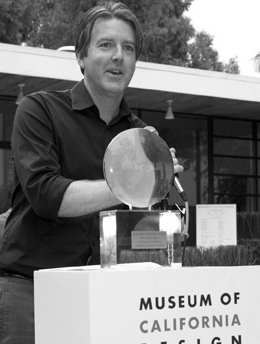 Colin Marshall sits down on top of the Walt Disney Concert Hall in downtown Los Angeles with Christopher Hawthorne, architecture critic at the Los Angeles Times and co-author of The Green House: New Directions in Sustainable Architecture. Last year, he conducted Reading Los Angeles, a yearlong study of the city through the books written about it. This year, he’s doing a series of essays and video explorations of Los Angeles’ boulevards: first Atlantic, then Sunset, and soon Crenshaw and beyond. They discuss the break from the city’s previous connection with the automobile, the single-family house, and private amenity; the unusual number of existential questions Los Angeles has faced and continues to face; outsiders’ visceral reaction to Los Angeles “inconsistent” architecture (especially as manifested by Randy’s and Dale’s Donuts), and the way freedom and ugliness can go hand-in-hand; his having grown up in Berkeley, a process that subjected him to a certain anti-Los Angeles “indoctrination”; the sense that Los Angeles is its “own thing,” and how that motivates deadening choices like freeways as well as enlivening choices like turning away from Europe and toward Latin America and Asia; Woody Allen and his attitudes about cities and urbanism, as revealed in films like Annie Hall and Midnight in Paris; how the stereotype of Los Angeles’ superficiality conceals its layered nature, and whether the city’s best elements can ever be made directly accessible; how to read cities versus reading objects, and how familiarity with Los Angeles helped him read a city like Houston; the complicated relationship between public and private space in Los Angeles, as exemplified by streets that simply give up on sidewalks and beloved midcentury modern houses in terribly alienating locations; and the tendency of tourists to see only the worst of Los Angeles and go no further — unless they go much, much further.
Colin Marshall sits down on top of the Walt Disney Concert Hall in downtown Los Angeles with Christopher Hawthorne, architecture critic at the Los Angeles Times and co-author of The Green House: New Directions in Sustainable Architecture. Last year, he conducted Reading Los Angeles, a yearlong study of the city through the books written about it. This year, he’s doing a series of essays and video explorations of Los Angeles’ boulevards: first Atlantic, then Sunset, and soon Crenshaw and beyond. They discuss the break from the city’s previous connection with the automobile, the single-family house, and private amenity; the unusual number of existential questions Los Angeles has faced and continues to face; outsiders’ visceral reaction to Los Angeles “inconsistent” architecture (especially as manifested by Randy’s and Dale’s Donuts), and the way freedom and ugliness can go hand-in-hand; his having grown up in Berkeley, a process that subjected him to a certain anti-Los Angeles “indoctrination”; the sense that Los Angeles is its “own thing,” and how that motivates deadening choices like freeways as well as enlivening choices like turning away from Europe and toward Latin America and Asia; Woody Allen and his attitudes about cities and urbanism, as revealed in films like Annie Hall and Midnight in Paris; how the stereotype of Los Angeles’ superficiality conceals its layered nature, and whether the city’s best elements can ever be made directly accessible; how to read cities versus reading objects, and how familiarity with Los Angeles helped him read a city like Houston; the complicated relationship between public and private space in Los Angeles, as exemplified by streets that simply give up on sidewalks and beloved midcentury modern houses in terribly alienating locations; and the tendency of tourists to see only the worst of Los Angeles and go no further — unless they go much, much further.
Download the interview from Notebook on Cities and Culture’s feed here or on iTunes here.
Post a Comment